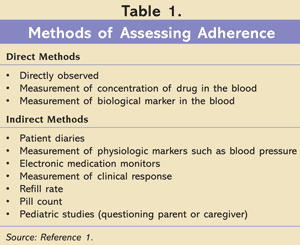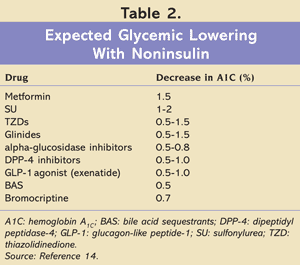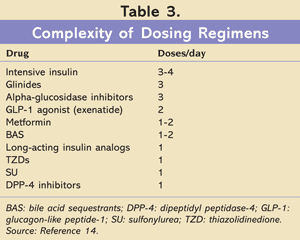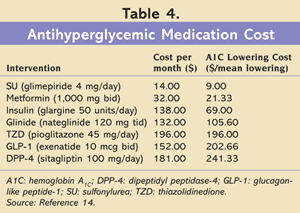US Pharm. 2010;36(4)(Compliance & Adherence suppl):11-15.
Former Surgeon General C. Everett Koop, MD, has often been cited for making the obvious but very poignant statement: “Drugs don’t work in patients that don’t take them.”1 There is a lot of wisdom in this remark that health care providers would do well to recognize and consider when choosing medications for their patients. While this statement was directed at pharmacotherapy in general, it is more likely to be a problem with the management of chronic disease, and may be at its worst, with the management of diabetes. Type 2 diabetes is a chronic, often silent condition that co-exists with a myriad of other medical problems. Hence, the patient may be taking multiple medications to treat several conditions such as diabetes, hyperlipidemia, and hypertension. This creates a complex situation that is likely to result in low adherence to the medication plan.
It seems reasonable that the provider could employ some “technique” or “method” in this population that would uniformly enhance adherence. Unfortunately, a recent scientific analysis of interventions to enhance patient adherence to medication prescriptions concluded that “current methods of improving medication adherence for chronic health problems are mostly complex, labor-intensive, and not predictably effective.”2 Still, even though no single method is predictably effective, there are methods that have been successful and clearly some common-sense tactics that can be applied, particularly when choosing medications to manage hyperglycemia in patients with type 2 diabetes.
This article will provide a succinct overview of the problem of nonadherence, an appraisal of its impact on the management of diabetes, and a common sense approach to improving compliance by choosing the medication most likely to promote adherence.
Adherence
Adherence to a medication regimen is usually defined as the extent to which patients take medications as prescribed.1 While adherence and compliance are virtually synonymous terms in the context of medication-taking behavior, some health care providers questioned the use of the term compliance, suggesting that adherence was preferable because it implies an alliance or a contract between the patient and the provider. While most health care providers now agree that the preferred term is adherence rather than compliance, the problem itself has not been lessened and remains a major problem. Average adherence rates in clinical trials (where one would anticipate high rates) are reported to be between 43% and 78% in patients treated for chronic conditions.1,3
The New England Healthcare Institute (NEHI) estimates that one-third to one-half of all patients in the United States do not take their medications as prescribed.4 Additionally, they estimate that the current (2009) cost of drug-related morbidity, which includes reduced adherence, accounts for 13% of total health care expenditures in the U.S. or approximately $290 billion annually.4 The National Council on Patient Information and Education estimates that poor adherence costs the U.S. health care system approximately $177 billion annually in total direct and indirect costs.5 Additionally, they attribute $47 billion annually to drug-related hospitalizations and estimate that as many as 40% of admissions to nursing homes are secondary to nonadherence to medication regimens.5
The study of adherence is at best an imprecise proposition. The choice of method used to study adherence is extremely important. There are a host of methods used to measure adherence, but none of these methods are appropriate in all situations, each having advantages and disadvantages. Therefore, no one method is considered the gold standard. These methods can be categorized as direct or indirect and are listed in TABLE 1.

The cause of poor adherence is complex, multifaceted, and varies with each situation and patient. Still, there are factors that when present predict poor adherence. The factors that have been verified by clinical trials to be major predictors of poor adherence include1:
- Presence of psychological problems such as depression
- Cognitive impairment
- Management of an asymptomatic disease
- Poor follow-up or discharge planning
- Side effects of medications
- Patient does not believe in the benefit of treatment
- Patient lacks insight into illness
- Poor relationship with prescriber
- Presence of barriers to care
- Missed appointments
- Complex treatment regimens
- Cost of medication (including high copayment).
One point mentioned in this list that is germane to the discussion is complexity of treatment regimens, and one measure of complexity with oral medications is frequency of dose. As frequency of dose increases, adherence is reduced in a stepwise fashion. Mean adherence rates for once-daily dosing are about 80% and drop to about 50% with four doses per day.1 Dosage frequency should therefore be a very important consideration in choice of medication.
As previously stated, methods of enhancing medication adherence are for the most part complex, labor-intensive, and not predictably effective; however, these interventions can sometimes be effective. Methods that have been shown to be effective can be divided into four categories: 1) patient education, 2) increased availability of the provider, 3) improved communication between the provider and the patient, and 4) adherence considerations regarding choice of medication.1,2,6
Adherence and Type 2 Diabetes
One measure of overall adherence to diabetes-management regimens is the assessment of patterns of self-monitoring of blood glucose (SMBG). One such evaluation was carried out in over 40,000 managed care patients with type 2 diabetes.7 The researchers reported that 67% of the patients with type 2 diabetes were not following American Diabetes Association (ADA) guidelines for monitoring (i.e., at least once daily). Several potential causes or associations for this were identified, including linguistic barriers, low education, and cost of the monitoring strips.7
Another small study evaluated the impact of dose frequency on medication adherence in patients (n = 91) with type 2 diabetes.8 The study reported that the average overall compliance rate was 74.8%. However, they noted a dramatic reduction in compliance based on the frequency of administration. Patients taking a one-daily dose had compliance rates of 79%, while patients taking three daily doses had compliance rates of 38%. The study also reported that the while the primary type of noncompliance was dose omission, more than 30% of the patients took too much medication. This seemed to be particularly pronounced in the once-daily dose group. The study concluded that while a reduction in dose frequency may result in an increase in compliance, it may also increase the risk of overconsumption.8
A study of antihyperglycemic medication usage patterns in the Medicaid population reported similar, if not more concerning, problems than the studies previously mentioned.9 This study evaluated 37,431 patients with type 2 diabetes in a 1-year follow-up study. Patients treated with monotherapeutic sulfonylurea or metformin had about 65% more adherent days (continuous and persistent use) than did patients treated with combination therapy. At the end of 1 year, only about 15% of the patients treated with monotherapy took their medication continuously and persistently. Worse yet, at the end of 1 year, <5% of the patients treated with combination therapy were taking their medication continuously and persistently.9 This study underlines the importance of simplification of regimen and also points out the difficultly of treating a chronic and often “silent” medical condition.
Myriad interventions to influence adherence have been evaluated in the setting of type 2 diabetes and have demonstrated mixed results. Adherence is the cornerstone of metabolic control, and it is widely accepted that any intervention designed to improve metabolic control hinges on our ability to influence patient self-care and/or self-management behaviors.10 While patient education is the foundation of long-term adherence, it is becoming obvious that psychological and behavioral interventions in concert with education are probably more effective than education alone. A review of adherence intervention trials reported a trend towards combining behavioral intervention and patient education.11 This review also demonstrated the short-term effectiveness of educational interventions and concluded that there was still a great need for determination of the best methods for improving patient adherence behaviors.
In addition to patient education/behavior interventions, two other approaches have been shown to improve self-management skills in patients with diabetes. The first targets health care providers. Several studies and reports have suggested that physicians and other health care providers often do not follow ADA or other appropriate guidelines and deliver less than optimal care to their patients with diabetes.10
Several studies of various types of interventions have been reviewed by the World Health Organization (WHO). One that was particularly interesting was carried out in Denmark.12 Physicians in the intervention group used and/or received diabetes-specific goal-setting information, feedback about their patients, and continuing education. Patients assigned to physicians in the intervention group had lower hemoglobin A1C (A1C) levels, lower blood pressure, lower fasting plasma glucose levels, and lower cholesterol levels at the end of the 6-year trial when compared to patients who received conventional therapy with nonintervention physicians. Intervention physicians also set up more follow-up consultations, referred fewer patients to diabetes specialty clinics, and set more optimistic goals for their patients.
Systems interventions attempt to alter the manner in which environmental factors direct self-management behavior in patients with diabetes. For example, systems interventions might focus on modulation of economic determinants such as changing health care policy to pay for blood glucose monitoring strips. This type of intervention may target policies or procedures or even entire programs to enhance the quality of care and improve outcomes for patients.
One successful example of this type of intervention, and a relatively simple one, was demonstrated in the United Kingdom in an outpatient diabetes clinic.13 Their objective was to reduce the rates of no-shows for diabetes appointments at their clinic. They targeted new patients. The intervention included either one or two components. First, all patients were sent an information package 2 weeks prior to each visit. This packet told them when and where to come, what to bring, where to park, who they would see, and what to expect. In the group receiving two interventions, the first intervention was followed 1 week later by a supplementary telephone call. Historic no-show rates prior to the intervention were 15%. Rates dropped in those receiving only the information packet to 7.3% and to 1.4% in those who also received the follow-up reminder call.13
Choice of Medication: Considerations to Enhance Adherence
It seems rather intuitive that one should consider the potential likelihood that a patient will adhere to a chosen medication regimen when that particular medication is being selected. In fact, most prescribers consider this question instinctively when prescribing or selecting a medication. Additionally, prescribers should also consider the amount of A1C lowering needed in that potential situation. Other factors must be considered as well, such as contraindications and drug interactions.
A1C Reduction Required: How much glycemic lowering is needed, and how much can be expected from a particular medication? While we can never predict precisely how much glycemic lowering will be realized from a particular medication in an individual, it is reasonable to consider the average glycemic lowering that is usually observed. Average glycemic lowering for the noninsulin medications are show in TABLE 2. Insulin is associated with glycemic lowering that is really only limited by hypoglycemia. Additionally, it should be remembered that typically greater glycemic lowering can be expected with higher A1C levels, and as 6.5% to 8% is approached, A1C lowering may become more difficult. Additionally, hypoglycemia is more likely to occur as one approaches euglycemic levels.

Patient Acceptance and Choice of Medication: One of the provider’s most potent forms of influence on whether or not a patient will be compliant with a drug regimen is choice of medication. Some of the other variables are difficult to modify and some may not be amenable to modification. These include age, gender, self-esteem, stress, depression, and alcohol or illicit drug use.10 Hence, choice of medication is a significant and malleable factor with regards to adherence. The potential acceptance of a medication regimen by a patient is, to a large degree, predicated on the complexity of regimen, cost, and the common side effects of that particular medication.
From a simplistic standpoint, complexity of a regimen may be evaluated by considering the number of doses needed each day. Based on studies previously cited, it is reasonable to assume that patients are more likely to be adherent to regimens that require fewer daily doses. TABLE 3 provides a look at the complexity of use of medications used to lower glycemic indices in patients with type 2 diabetes. This simple method of assessing complexity is useful but does not take into consideration the variable of route of administration. While the injectables are probably associated with a lower level of patient acceptance, most patients, when properly educated, seem to adapt to their use. Even with injectables, patients prefer single daily dosing to multiple daily doses.

Statements regarding the impact of specific cost of a medication on adherence in a general population are very difficult to make. This is due to the disparity between cost of the medication and what the patient actually pays, which is governed by third-party payers (or lack of) and manifold other factors. While the cost of medication is a direct consideration in the patient who pays full price out-of-pocket, it is probably also a reasonable factor to consider even in patients with some form of medical insurance or prescription coverage. Even in those patients, their out-of-pocket costs are often linked to actual cost, and choosing lower-cost medications for those patients reduces the overall burden on the health care system.
The data shown in TABLE 4 is a snapshot of the cost per month of average doses of commonly used antihyperglycemic agents.14 In addition to the cost per month, perhaps more importantly, an estimate of the cost of average glycemic lowering is provided. This value was derived by dividing the monthly cost of the medication by the expected reduction in A1C. Based on this approach, it is obvious that sulfonylureas, metformin, and insulin are typically the most cost-effective medications.

Common side effects should also be considered. While the provider must always be cognizant of and consider more uncommon side effects, adherence is more likely to be influenced in each patient by common events. While each category of antihyperglycemic medication carries with it a set of side effects, the two most common, and probably most salient from a side-effect profile, are hypoglycemia and weight gain. In addition to impacting adherence, these two side effects are also an important consideration from the perspective of morbidity and mortality. Hypoglycemia is not an uncommon occurrence with monotherapeutic insulin, sulfonylureas, or glinides, although its rates are quite low with the glinides.14 Hypoglycemia is not likely to occur with monotherapeutic metformin, thiazolidinediones (TZDs), or glucagon-like peptide-1 (GLP-1) agonists (e.g., exenatide, liraglutide), also known as gliptins, but may occur at slightly higher rates when these agents are added to other antihyperglycemic agents (particularly insulin or
sulfonylureas).
Lastly, weight gain is most likely to occur with the addition of insulin or sulfonylureas and to a lesser extent the glinides. Weight gain may also occur with the addition of a TZD, and there is still some debate as to whether or not this is “real” weight or edema. Metformin and the gliptins are weight neutral in most cases. Exenatide is associated with mild-to-moderate weight loss and is one factor that often makes it an attractive choice.
Conclusion
Lack of patient adherence to medication regimens is a significant problem in the management of diabetes. Interventions to alter patient or provider prospective work in some cases but are not always predictably successful. One simple method of enhancing adherence is the thoughtful choosing of medications, which includes consideration of glycemic lowering needed, complexity of the regimen, and common side effects. While most providers do this intuitively, it may be useful to consistently do this in a systematic fashion.
REFERENCES
1. Osterberg L, Blaschke T. Adherence to medication. N Engl J Med. 2005;353:487-497.
2. McDonald HP, Garg AX, Haynes RB. Interventions to enhance patient adherence to medication prescriptions: scientific review. JAMA. 2002;288:2868-2879.
3. Claxton AJ, Cramer J, Pierce C. A systematic review of the associations between dose regimens and medication compliance. Clin Ther. 2001;23:1296-1310.
4. Thinking Outside the Pillbox: A System-wide Approach to Improving Patient Medication Adherence for Chronic Disease. Cambridge, MA: New England Healthcare Institute; 2009. www.nehi.net/publications/44/
5. Enhancing Prescription Medicine Adherence: A National Action Plan. Rockville, MD: National Council on Patient Information and Education (NCPIE); 2007. www.talkaboutrx.org/documents/
6. Kocurek B. Promoting medication adherence in older adults…and the rest of us. Diabetes Spectrum. 2009;22;2:80-84.
7. Karter AJ, Ferrara A, Darbinian JA, et al. Self-monitoring of blood glucose: language and financial barriers in managed care population with diabetes. Diabetes Care. 2000;23:477-483.
8. Paes AH, Bakker A, Soe-Angie CJ. Impact of dosage frequency on patient compliance. Diabetes Care. 1997;20:1512-1517.
9. Dailey G, Kim MS, Lian JF. Patient compliance and persistence with antihyperglycemic drug regimens: evaluation of a Medicaid patient population with type 2 diabetes mellitus. Clin Ther. 2001;23:1311-1320.
10. World Health Organization. Adherence to Long-term Therapies: Evidence for Action. Geneva, Switzerland: World Health Organization; 2003. www.who.int/chp/knowledge/
11. Brown SA. Interventions to promote diabetes self-management: state of the science. Diabetes Educ. 1999;25:52-61.
12. Olivarius ND, Beck-Nielsen H, Andreassen AH, et al. Randomised controlled trial of structured personal care of type 2 diabetes mellitus. BMJ. 2001;323:1-9.
13. Hardy KJ, O’Brien SV, Furlong NJ. Information given to patients before appointments and its effect on non-attendance rate. BMJ. 2001;323:1298-1300.
14. White JR, Campbell RK. Overview of medications used to treat type 2 diabetes. In: Medications for the Treatment of Diabetes. Montvale, NJ: American Diabetes Association/Thomson Reuters; 2008:5-15.
To comment on this article, contact rdavidson@uspharmacist.com.





